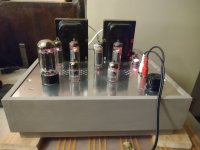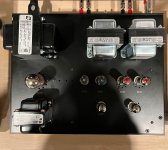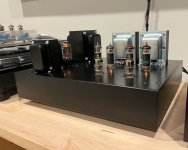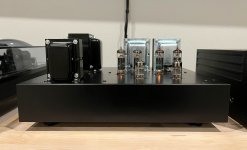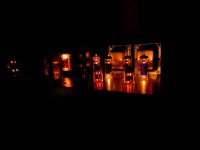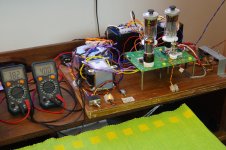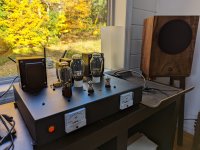Hi OldHector,
is the CL-140 on secondary side also recommended for a tube rectifier, or only at silicon diodes?
is the CL-140 on secondary side also recommended for a tube rectifier, or only at silicon diodes?
I added the CL140 to the secondary side in the SSE amp board back in 2011. This was a point in time where all three of the major new production tube makers were selling poor quality 5AR4 tubes. The rectifier tube must try to fill the empty filter caps in a tube amp while it is warming up. This requires a uniformly coated cathode concentrically mounted in the plate so that all the start up current does not happen at a single point. A thin spot in the coating will heat faster and start to emit electrons first. A point where the cathode is closer to the plate than normal will flow more current than the rest of the cathode. If the current density is too high in eeither case the tube will arc further damaging the coating. Many SSE's built with modern cost reduced (less wire for less resistance) pushed the 5AR4 near it's spec limit and some brand new tubes sparked out on first power on. The CL90 on the primary slows the inrush caused by the low cold resistance of the tube heaters. The CL140 on the secondary side doesn't begin to act until the rectifier tube starts to conduct, blunting the current surge which saves marginally constructed tubes.
In the case of silicon diodes the CL140 keeps the peak charging current down making life easier on the diodes, transformer and first capacitor. I generally only used the CL140 in SSEs or other applications where a tube rectifier is pushed near the spec.
I have also seen a CL140 burst into flames if the total peak current is high enough. Here I was using a 480 volt industrial control transformer (very low DCR), a bunch of series diodes, and big polypropylene cap. There is a maximum spec for these things, but serious math is required to use it and most use cases for tube amp builders are within the spec.
In the case of silicon diodes the CL140 keeps the peak charging current down making life easier on the diodes, transformer and first capacitor. I generally only used the CL140 in SSEs or other applications where a tube rectifier is pushed near the spec.
I have also seen a CL140 burst into flames if the total peak current is high enough. Here I was using a 480 volt industrial control transformer (very low DCR), a bunch of series diodes, and big polypropylene cap. There is a maximum spec for these things, but serious math is required to use it and most use cases for tube amp builders are within the spec.
My third and final SPP.. I decided to go with an offboard rectifier and I really like the layout of this one. First filter cap is next to the rectifier for a short loop.
These are custom Sowter 8K transformers with 25% Ultra-linear taps, their frequency response is flat from lower bass over 20khz (measured with ARTA).
That said, with the 4 independent secondaries, it was an absolute pain to wire for switching 4/8 ohms output.
These are custom Sowter 8K transformers with 25% Ultra-linear taps, their frequency response is flat from lower bass over 20khz (measured with ARTA).
That said, with the 4 independent secondaries, it was an absolute pain to wire for switching 4/8 ohms output.
Attachments
My SSE just got married with an pre-amp and RIAA designed by Morello (https://www.sybariteaudio.se/) as a DIY kit. They are driven by E83CC and E88CC.
From left to right: RIAA, Pre-amp, SEE, Choke (motor condensator to be fitted) and a pair of GSXE 15-8k-5.
As he RIAA and Pre-amp has a power bord and the weight of the power transformers became significant are they placed on a separate fixture. Which will be placed with distance to all low-level signals.

As the family are growing do I need to accommodate them in a bigger cabinet both for space issues and for handling all the heat. I found and old Radio furniture at a flea market for a reasonable cost.
The Frugalhorn MK3 with TB W4-2142 are built to match the SSE, the system plays down to about 60Hz (-3db) which I find suitable to my flavor of music.

A comment on using a Pre-amp: I have to say that this really lifted the SSE. Have played the SSE with direct source as BT-streamer, CD-player and cellphone 3,5mm (not fair) with a simple trim-pot for volume control. With the pre-amp do I have a significant improvement of the sound, the bass are really deep and tight. However do I have to be careful, I can now crank the SSE into clipping, which was not possible before.
From left to right: RIAA, Pre-amp, SEE, Choke (motor condensator to be fitted) and a pair of GSXE 15-8k-5.
As he RIAA and Pre-amp has a power bord and the weight of the power transformers became significant are they placed on a separate fixture. Which will be placed with distance to all low-level signals.
As the family are growing do I need to accommodate them in a bigger cabinet both for space issues and for handling all the heat. I found and old Radio furniture at a flea market for a reasonable cost.
The Frugalhorn MK3 with TB W4-2142 are built to match the SSE, the system plays down to about 60Hz (-3db) which I find suitable to my flavor of music.
A comment on using a Pre-amp: I have to say that this really lifted the SSE. Have played the SSE with direct source as BT-streamer, CD-player and cellphone 3,5mm (not fair) with a simple trim-pot for volume control. With the pre-amp do I have a significant improvement of the sound, the bass are really deep and tight. However do I have to be careful, I can now crank the SSE into clipping, which was not possible before.
It doesn't hurt to put it there, but doesn't do much good in that position, since the rectifier tube
provides a slow upramping startup. The tube heaters need that protection since they do see a surge current upon power up. Put the inrush limiter on the primary side of the power xfmr to get the benefit from the limiter.
SSE with GU50
I read that the GU50 may work with the 12AT7 as driver tube and thought of trying it with the SSE. I had to cut tracks to change the heater voltage and
trafo secondary for the heaters is 0-12.6v.
In triode the tube sounds beautiful. It has a full-bodied rounded sound like the 6L6 family. My setup is running with Softone RW-20 OPT. The primary is 340v and the GZ34 gets me about 380v on the plate. The cathode R is ~490, so around 28w give or take.
You also need an adapter from 6L6GC --> GU50.
I read that the GU50 may work with the 12AT7 as driver tube and thought of trying it with the SSE. I had to cut tracks to change the heater voltage and
trafo secondary for the heaters is 0-12.6v.
In triode the tube sounds beautiful. It has a full-bodied rounded sound like the 6L6 family. My setup is running with Softone RW-20 OPT. The primary is 340v and the GZ34 gets me about 380v on the plate. The cathode R is ~490, so around 28w give or take.
You also need an adapter from 6L6GC --> GU50.
Attachments
I use an inrush current limiter on the primary in all of my tube amps. The part number depends on the amp specifics The additional CL140 between the rectifier tube and the first filter cap is there mainly to prevent rectifier tube damage at power up. A well made rectifier tube should be OK in an amp where the maximum capacitance spec is observed, but back around 2010 brand new 5AR4's from the three usual new production suppliers were popping at first power up. Sometimes two or three tubes were tried to find a good one, and that got expensive. The CL140 saved all but the really poorly constructed tubes. A DH rectifier like a 5Y3 or 5U4 may spark out on power up, but it usually survives. In most cases a 5AR4 that sparks once will usually spark again until it is destroyed.It doesn't hurt to put it there, but doesn't do much good in that position, since the rectifier tube
provides a slow upramping startup. The tube heaters need that protection since they do see a surge current upon power up. Put the inrush limiter on the primary side of the power xfmr to get the benefit from the limiter.
Tubelab SSE
Output Transformers Hashimoto HC-507U
Power Transformer Hashimoto PT-165R
Choke Hashimoto CC-10-200W
Tube rectification only (no D1 & D2)
B+ around 435V



This is the first amplifier I've built, so glad I could make it 😎
Thanks to @Tubelab_com and the whole diyAudio community, your posts have been so helpful, all the questions I had along this journey were answered on the site or here 👍
I've been listening to it all weekend and I'm pretty happy with it so far
What would be the next step (before there are no boards left), SPP or TSE-II ?
Output Transformers Hashimoto HC-507U
Power Transformer Hashimoto PT-165R
Choke Hashimoto CC-10-200W
Tube rectification only (no D1 & D2)
B+ around 435V
This is the first amplifier I've built, so glad I could make it 😎
Thanks to @Tubelab_com and the whole diyAudio community, your posts have been so helpful, all the questions I had along this journey were answered on the site or here 👍
I've been listening to it all weekend and I'm pretty happy with it so far
What would be the next step (before there are no boards left), SPP or TSE-II ?
Sales of Tubelab boards has been so weak this year that running out of boards is probably not an issue for 2024. In 2023 there were 101 orders for boards. So far this year, there have been 27. As long as the sales income covers the fixed costs, I'll keep replenishing stock of existing boards and continue working on some new stuff. It's not just Tubelab, other people in the "non essential needs" or "hobby stuff" business have expressed a similar sales drop off which has grown worse with time during 2024. Some friends in the surplus equipment, or surplus electronics sales business have liquidated and closed down as warehouse rent and other fixed costs went up as sales revenue went down.What would be the next step (before there are no boards left), SPP or TSE-II ?
The SPP is a build it and play push pull design for 15 to 20 watts per channel. Construction is much like the SSE. The TSE-II is a Single Ended amp that uses DHT (directly heated, or filamentary triode) tubes like the 2A3, 45 or 300B. Once assembled it requires making adjustments on a live amp to set the operating conditions for each tube.
Has anyone done any CAD work for the TSE-II board? This is so I can automate a top plate cutout.
Cheers,
Greg
Cheers,
Greg
Hi Greg. I've done an AutoCAD drawing for my TSE-II builds. Does that work for you ?
Finished the 300b into a chassis today. This completes the DHT Triode 'Holy-Grail' for me - 2A3 & 300b.
Thank you George 😀
Thank you George 😀
Hi, I uploaded a .step file for a complete 300B TSE-II amplifier. The mounting hole circled below is so close to the hole for the tube that I did not include it and planned to 3d print an adapter to offset this hole. I have not built this version of the amp, so check the hole locations against your board carefully. Let me know if you need a different format and I will see what I can do.

Attachments
- Home
- More Vendors...
- Tubelab
- Pictures of your Tubelab amp
